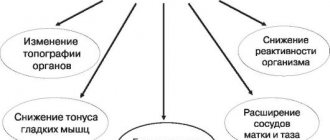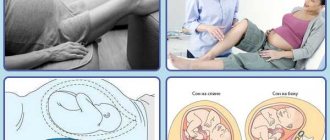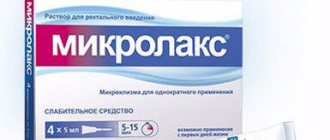With inflammation of the female appendages, that is, the ovaries and fallopian tubes, women most often turn to a gynecologist. The health risks of any inflammatory process are clear. But the body of a woman carrying a child is especially vulnerable to it. Inflamed appendages usually lead to an exacerbation of the chronic process in expectant mothers, and sometimes to acute inflammation of the ovaries. That is why it is no coincidence that gynecologists strongly recommend undergoing a medical examination before planning to conceive a child.
Symptoms of inflammation of the appendages in pregnant women
You should think about whether the appendages are inflamed if there is pain in the lower abdomen, especially if the pain radiates to the lumbosacral spine. Usually this pain is paroxysmal, but sometimes it is constant. As a rule, the causes of its occurrence are physical or mental stress, reduced immunity of the body, as well as hypothermia. Another symptom is leucorrhoea of a milky or yellow-green hue that discharges from the vagina.
If a woman has:
- a sharp increase in temperature,
- chills,
- feeling of general weakness,
- pain in the lower abdomen,
- purulent discharge - inflammation occurs in an acute form.
Diagnosis of colpitis in the early stages
Diagnosis of colpitis includes the following activities:
- Examination on a gynecological chair.
Already by visualizing vaginal discharge, the gynecologist can assume the presence of an infection or even a specific pathogen. For example, yellow purulent ones are characteristic of gonococci, abundant white ones - for chlamydia, foamy ones - for Trichomonas, etc. - Taking smears for flora from the vagina and cervix.
Using them, you can confirm the fact of inflammation, but you cannot specify the specific pathogen (with the exception of yeast fungi, Trichomonas and sometimes gonococci). However, it is a valuable method for monitoring treatment or in cases where a more in-depth study cannot be performed. - Oncocytology smears indicate whether there is inflammation in the cervical canal.
This is extremely important, since the presence of infection here increases the likelihood of infection of the fertilized egg. - Sowing vaginal contents for flora and sensitivity to antibiotics is one of the reliable diagnostic methods. With its help, you can not only identify pathogens, but also determine their number. This is extremely important for opportunistic flora, which may be present in a certain titer and is normal.
Culture can also be used to determine the sensitivity of pathogens to antibiotics. In the “era of microbial resistance” to drugs, this helps to select the safest and most effective treatment.
- PCR for possible infections is one of the fastest, most reliable methods.
They can identify any pathogen, even if it is found in minimal quantities in vaginal secretions. PCR is the “gold standard” for detecting many infectious diseases, including STIs. - The ELISA method for determining immunoglobulins can also provide some information.
But often it is not reliable, false positive or does not matter at the moment. After all, ELISA shows the state of immunity in relation to a specific microbe.
Consequences of inflammation of the appendages in expectant mothers
| Consequences | Causes |
| Ectopic pregnancy (when the fallopian tube becomes the basis for attachment of the fertilized egg.) | This happens because, as a result of inflammation, the fallopian tube partially loses its patency. The larger egg does not penetrate the uterus. But smaller sperm penetrate into the egg and fertilize without any problems. The embryo in the fertilized egg is actively developing, but the fallopian tube on which it is attached cannot stand it and ruptures. The way out of the situation would be to surgically remove the fertilized egg in order to preserve the fallopian tube and give the woman the opportunity to undergo the necessary treatment and become pregnant again. |
| Spontaneous miscarriage (any month of pregnancy) | It happens if the inner layers of the uterus are damaged, so that the latter rejects the embryo, perceiving it as a foreign element. |
| Non-developing pregnancy (fetal fading) | It happens that the inflammation of the appendages has taken a chronic form, resulting in the body producing antibodies to its own cells. Thromboses form. As a result, the placenta exfoliates and the development of the embryo in the womb is delayed. Other reasons for a non-developing pregnancy are impaired activity of the immune system, which recognizes and blocks the development of elements dangerous to the body. As a result, the effect of blood cells on the placenta and fetus becomes toxic, thereby preventing their development. |
| Infection of a child | It happens if the cause of inflammation of the appendages is infectious. And even if the infection did not affect the child during intrauterine development, he can become infected during childbirth. The solution to this situation would be a caesarean section. |
In addition, inflammation of the appendages can result in the absence of an embryo in the ovum, premature birth or fetal death for a pregnant woman. You should remember this and contact your gynecologist in a timely manner (preferably within the first week after conception).
Endometritis
Endomeritis is an infectious disease of the internal tissues of the uterus that is inflammatory in nature. Such inflammation occurs as a result of ascending infections of the external organs of the genitourinary system, or mechanical damage to the uterine cavity as a result of abortion, childbirth, examination of the fallopian tubes, probing, or curettage of the uterine cavity, etc. For a pregnant woman, this disease is especially dangerous, since in the absence of timely and adequate treatment can lead to the death of the child.
Treatment of endometritis
This gynecological disease is one of the most complex and dangerous. When treating it, first of all, as in all previous cases, the nature of the primary infection is determined and only then treatment is prescribed. According to medical statistics, antibiotics or antiviral drugs are used to treat endometritis.
Adnexitis in pregnant women
A healthy pregnancy and bearing a full-fledged child is the most important goal of every woman. Many people are frightened by terrible diagnoses without fully understanding the situation. The problem of inflammation of the female genital organs accounts for the maximum number of visits to gynecology. This is due to many circumstances: the onset of sexual activity earlier than expected by nature, the inconsistency of the sexual partner and irregular visits to the doctor.
The appendages are the ovaries and fallopian tubes. It is these internal female genital organs that are responsible for healthy fertilization and gestation. Inflammation of the appendages during pregnancy always sounds like a death sentence, but it is not so scary with timely diagnosis and proper treatment and observation.
The use of folk remedies in the treatment of inflammation of the appendages in expectant mothers
Traditional medicine has accumulated a lot of methods for treating appendages, but not all are suitable for pregnant women. Here you should immediately reject alcohol infusions and steam baths using herbs: they negatively affect the development of the embryo, and in some cases lead to spontaneous miscarriage.
Much more useful:
- Infusions and medicinal decoctions, the basis of which can be St. John's wort, sweet clover herb, blueberry leaves, thyme, coltsfoot, oak bark, chamomile flowers, marshmallow and yarrow roots, hair of blind corn cobs. Here is a recipe for an infusion of St. John's wort, which, according to popular belief, relieves 99 ailments: St. John's wort is brewed as tea and drunk three times a day before meals. According to a similar scheme, infusions from everything else are prepared and taken. Mixing herbs is acceptable;
- Douching with herbal decoctions. The best way to eliminate inflammation is chamomile or calendula;
- Pumpkin, the bigger the better. This includes eating the pulp of the vegetable and drinking freshly squeezed juice. This is not only an effective method of treatment, but also a way to saturate the body with vitamins;
- Aloe juice. Take one dessert spoon three times a day before meals, optionally with honey.
Traditional methods of treating appendages allow you to solve the problem without using medications. However, treatment takes a long time and requires consultation with a doctor. This is especially true for douching. Plants for decoctions should be selected with extreme caution: some of them can cause miscarriage.
An indispensable condition before using them is familiarity with the side effects that they can have on the body.
Symptoms of the disease
The manifestations of pneumonia in each trimester of pregnancy do not differ from usual ones.
In the first 2-3 days, symptoms of a standard ARVI without complications are identified.
We are talking about cough, runny nose, significant weakness and slight low-grade fever.
Over the course of several days (less often a week or more), the symptoms present increase, after which forced pain develops in the sternum on one or each side.
The inflammatory process in the lungs at the secondary stage of development is associated with the following symptoms:
- painful sensations intensify during the process of removing sputum and during deep breathing;
- temperature indicators reach 39-39.5 degrees;
- shortness of breath and tachycardia develop in a compensatory manner;
- The cough may be dry, barking, or wet, producing purulent (sometimes bloody-rusty) sputum.
Other symptoms that develop in the final stages or with additional complications appear less frequently. Treatment should be adjusted depending on them.
Reviews from pregnant women who suffered from inflammation of the appendages
Currently, inflammation of the appendages is one of the popular topics in various communities, where pregnant women, as well as women who have recently given birth, share their experiences. Some members of the forum categorically deny the possibility of getting this inflammation during pregnancy. Others, despite the fact that they have chronic inflammation of the appendages, did not experience any particular difficulties in bearing and giving birth to a child. They are happy to share their favorite methods of treatment, and they name not only those listed above. Some women in the second half of pregnancy used Viferon and Viburkol suppositories. If they had pain due to stretching of the adhesions remaining after inflammation (this is a side effect of chronic inflammation of the appendages), they reduced it by wrapping their lower back with a warm scarf or belt. And they achieved amazing results.
But no advice in thematic communities can replace consultations with a gynecologist, a full examination and constant monitoring throughout the entire period of the disease.
Treatment
Adnexitis diagnosed during pregnancy requires hospital treatment. The expectant mother should be under constant medical supervision. The main task is a quick response to the disease.
It is necessary to stop the development of the inflammatory process as urgently as possible, and most importantly, to prevent the infection from penetrating through the placenta to the unborn baby. With the correct and coordinated actions of doctors, it is possible to “freeze” the process and give birth to a healthy toddler.
Treatment of inflammation of the appendages is often done with antibiotics. To do this, a test is taken for sensitivity to the components of drugs that are approved for use during pregnancy. The risk of harm to the fetus must be eliminated.
Treatment is necessarily accompanied by drugs that increase general and local immunity. After completion of treatment, it is necessary to restore the vaginal microflora in order to prevent further infections until childbirth.
Causes
The most common causes of adnexitis during pregnancy are:
- Streptococci, chlamydia, E. coli, staphylococci, mycobacterium tuberculosis and other pathogenic microorganisms;
- Endometritis;
- Weakened immune system;
- Overwork, stress;
- Pyelonephritis, tonsillitis, etc.;
- Abortion, surgical intervention in the female reproductive organ system;
- Endocrine or hormonal pathologies;
- Hypothermia, swimming in cold waters;
- Poor nutrition;
- Sexual relations during menstruation;
- The IUD stays inside the uterus for a long time.
Infectious agents can penetrate a woman's appendages through poor personal hygiene or sexual contact. Adnexitis cannot occur without an obvious reason. Almost every case of pathology is preceded by inflammation of the lower genital tract. For example, damage to the cervical canal, vagina or urethra. Lack of proper treatment contributes to the spread of dangerous bacteria to other organs of the reproductive system. For this reason, salpingoophoritis is often accompanied by endometritis, as well as other diseases of the pelvic organs.
When planning a pregnancy, it is necessary to take measures to eliminate these factors. Successful conception and bearing of a baby directly depends on the prevention and treatment of adnexitis.










